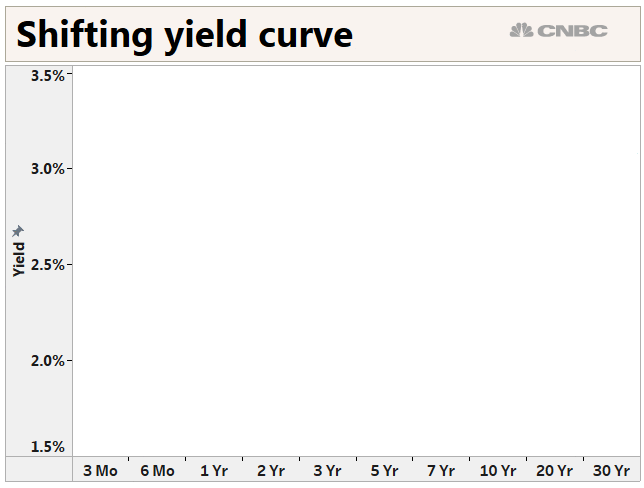The bond market is edging closer to signaling a recession, but don't panic yet. Stocks could have a lot more room to run even if the feared "yield curve" inverts, history shows.
The spread between the 3-month Treasury bill and the 10-year note went into negative territory on Friday, the first time since 2007. The more widely watched part of the curve — the gap between yields on the 2-year and 10-year debt — is getting closer to inversion as well, falling to just 10 basis points, versus 60 basis points a year ago. The yield curve has been a reliable recession indicator in the past.
This occurred after the Federal Reserve this week downgraded the U.S. economic outlook and signaled no rate hikes this year, worrying bond traders that a possible recession is in the near future.
However, if history is any guide, equity investors shouldn't worry in the near term. In fact, stocks rose about 15 percent on average in the 18 months following inversions, according to a Credit Suisse analysis last year. The data show the stock market tends to turn sour about 24 months after the yield curve inverts. Three years after an inversion, the S&P 500 is up just 2 percent on average as stocks take a hit on recession fears.
#dw-chart{width: 100%;height: 500px;border: none;padding-top: 32px;box-sizing: border-box;-moz-box-sizing: border-box;-webkit-box-sizing: border-box;}"Yield curve inversion won't signal doom," Jonathan Golub, chief U.S. equity strategist at Credit Suisse, said in a note last year. "While an inversion has [preceded] each recession over the past 50 years, the lead time is extremely inconsistent, with a recession following anywhere from 14-34 months after the curve goes upside down."
The most recent recession, in 2008, came 24 months after the 2-year and 10-year yield curve inverted on Dec. 30 in 2005, Golub pointed out. Back then, the stock market scored an 18.4 percent gain 18 months after the inversion and 17 percent return 24 months later, the analyst said.
Stocks started to go downhill only about 30 months after the inversion in 2005 as the S&P 500 eventually wiped all the gains around mid-2007 and lost a whopping 30 percent in early 2009 as the great financial crisis raged, according to Credit Suisse.

The stock market has jumped 21 percent from its Christmas Eve low as fears of an economic downturn and a full-on trade war with China recede. However, the rally was put on hold this week as the Fed's policy reversal reignited the recession fears. The central bank announced no rate hikes this year versus the two rate increases that were predicted as recently as December, and it also reduced its outlook for GDP to 2.1 percent in 2019 from a 2.3 percent forecast in December.
"Our core logic behind the inversion call still holds — it's a bet the market will begin pricing in a 'policy error' risk," said Ian Lyngen, BMO's head of U.S. rates, in a note. "Unlike when the Fed was still clinging to the hope of another hike or two in 2019, an inversion now will occur as investors worry the FOMC's on hold stance will prevent them from cutting rates quickly enough to stave off a more severe recession."
No comments:
Post a Comment